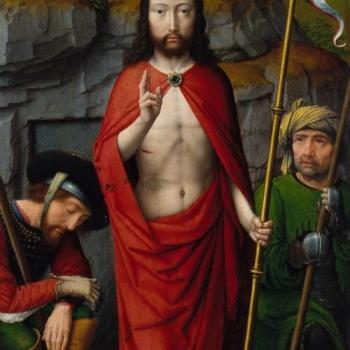Turns out not so much as you might think.
Here’s the thing about the gospels. There really is nothing quite like them in the annals of world literature and the sooner you confront that fact, the less chance you have of the media making you stupid about them.
On the one hand, the gospels clearly have a sacramental and theological view of the world. It is a world charged with meaning and sacramental power. So every detail they record has symbolic significance. Jesus is born, not just anywhere, but in Bethlehem, the House of Bread. He is laid in a manger–a feed box, and Luke notices that because Jesus is the Bread of Life. Luke will make the same eucharistic connection at the other end of his gospel by recording that he was made known “in the breaking of the bread”. So it becomes easy, once you have gotten used to reading the gospels for all their massive amount of sacramental symbolism, to start imagining that the symbols are being invented and not reported by the authors.
Only here’s the thing, the gospel writers absolutely insist that they are reporting, not inventing this story. The action takes place not in cloud cuckoo land, but in various locales around the Holy Land. It happens not once upon a time, but “In the fifteenth year of the reign of Tiberi-us Caesar, Pontius Pilate being governor of Judea, and Herod being tetrarch of Galilee, and his brother Philip tetrarch of the region of Ituraea and Trachonitis, and Lysani-as tetrarch of Abilene, in the high-priesthood of Annas and Caiaphas”. Indeed, Luke explicitly tells us, “Inasmuch as many have undertaken to compile a narrative of the things which have been accomplished among us, 2* just as they were delivered to us by those who from the beginning were eyewitnesses and ministers of the word, 3* it seemed good to me also, having followed all things closely * for some time past, to write an orderly account for you, most excellent Theophilus, 4* that you may know the truth concerning the things of which you have been informed.”
Sorry, but this ain’t the language of myth even though the events reported have a mythic quality. This is the language of an ancient chronicler. Moreover, it is the language of an ancient chronicler who is quite careful to get his facts straight and has been shown, on repeated occasions, to know what he is talking about *better* than modernist scholars who are ready to dismiss him as having made crap up.
That’s why it’s so hilarious that when the Atheist Human Toothache Brigade turns out in full force, worshipping and not using their intellects and managing to not only gratuitously offend Christians and even non-Christians at Christmas, but doing it in a way that reflects maximum stupidity. Behold the “Keep the Merry, Dump the Myth” ad campaign:
What image do the geniuses of American Atheists choose to illustrate the “myth” of Jesus? Not even the Star of Bethlehem or the Visit of the Magi or much of the other trappings of Christmas which have long been fodder for people who want to mythologize the gospel, though this too is not nearly the slam dunk you’d think). No: the Way Smarter Than You American Atheists take the one thing about Jesus most emphatically agreed upon as definitely a fact of history–his crucifixion–and declare *that* a myth. Brilliant, guys.
Here’s some reality: actual biblical scholarship by real, you know, scholars (even, by the way, unbelieving scholars) laughs to scorn the notion that “Jesus never existed”. What is quite clear is that the gospel are eyewitness accounts of a very real Jesus of Nazareth. And what is most solidly and definitely established by any reasonable assessment of the records we have is that, in the words of Tacitus, “Christus… suffered the extreme penalty during the reign of Tiberius at the hands of one of our procurators, Pontius Pilatus.” Only a crank–or a member of American Atheists–denies this.
Are the gospels theologized (that is, sacramental) accounts which regard historic events–particularly the historic event we call the Incarnation–as charged with the grandeur of God and filled with spiritual meaning and connections to the Old Testament? Sure. But the evangelists absolutely deny they are making the story up and (what is more) the internal details of the gospel make the claim that they are inventions or that Jesus never existed simply incredible. All sorts of details nobody would invent–Jesus being tired, hungry, thirsty, terrified, and forsaken; statements like “Why do you call me good? There is none good but God”; Jesus professing ignorance–not to mention quirky details that have the stamp of historical memory all over them–all these things scream “chronicle” not myth. It frankly takes far more faith to say Jesus never existed than to acknowledge the obvious fact that he did. That’s why none of Jesus’ earliest enemies, Jewish or pagan ever attempted to deny his historicity. They called him a magician, demon-possessed or the product of a rape. But they never called him a myth. It took the folly of postmoderns swelled with pride over their superior reason to embrace this supremely unreasoning… myth.
For a bit more along the same lines, Fr. Dwight Longenecker writes on the gospel of Mark here. Also, if you are interested in delving into the very impressive scholarship of Richard Bauckham and getting your information about the New Testament from somebody who knows what he’s talking about and not from ignorami with a big poster in Times Square, I highly recommend his Jesus and the Eyewitnesses: The Gospels as Eyewitness Testimony. We are now living in age when the basic assumption is not the factuality of the gospels, but that they are total frauds. It is fun to be part of a counter-culture speaking truth to power and Bauckham supplies some very powerful intellectual backing for those who use vs. those who merely worship, their intellects.











